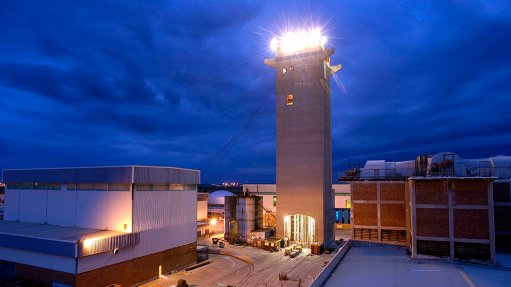
Name: Kopanang mine.
Location: Kopanang is located in South Africa’s Free State province, about 170 km south-west of Johannesburg and 10 km south-east of Orkney.
Controlling Company: AngloGold Ashanti.
Brief History: Shaft sinking started at Kopanang in 1977 and was completed by 1981, with production beginning in 1984.
Brief Description: Two gold-bearing reef horizons are accessed using a twin-shaft system that descends to a maximum depth of 2 334 m, while the main working levels are situated between 1 300 m and 2 064 m below surface.
Geology/Mineralisation: Kopanang is situated in a structurally complex area of the Witwatersrand basin, which has been subjected to numerous tectonic events. The Vaal reef (VR) is the main economic horizon at Kopanang and the C reef (CR) is the secondary economic horizon. Both reefs are part of the Witwatersrand Supergroup and are stratigraphically located near the middle of the Central Rand Group. The CR forms the top of the Johannesburg Subgroup, while the VR lies about 265 m below the CR. The two tabular bodies are gold- and uranium-bearing. Currently, only the VR is mined, with limited CR mining planned during the life-of-mine. The CR is accessible through the VR infrastructure. These conglomerate units dip at an average of 21° towards the south and occur in a 2 100-m-thick sedimentary sequence comprising the Central Rand Group.
Mining is complicated by the presence of an assortment of steep (85° to 50°) north-dipping and younger, low-angle (50° to 15°) south-dipping faults. The interplay of these main fault regimes, along with abundant pre- and postdating dykes, makes for a complex and geologically challenging deposit.
A geological model is used to delineate variations in characteristics of the VR. The current geological model thus subdivides the VR into homogeneous zones – referred to as geozones, facies or estimation domains, based on geological and grade characteristics.
Reserves: Total proved and probable reserves as at December 31, 2014, were 6.45-million tonnes grading 6.02 g/t of gold.
Resources: Total inclusive mineral resources as at December 31, 2014, were 9.9-million tonnes grading 14.86 g/t of gold. Total exclusive mineral resources were 3.32-million tonnes grading 26.63 g/t of gold.
Products: Gold, with uranium oxide produced as a by-product.
Mining Method: A sequential grid-mining layout is used, from which scattered mining takes place.
Major Infrastructure and Equipment: The VR and the CR are accessed using a twin-shaft system.
Prospects: The reef-boring project at Kopanang is focused on improving the current mining method to better extract the lower-value reefs. The new technology aims to increase productivity, improve gold recovery, reduce development costs and improve safety. Testing of the reef-boring initiative is continuing on the 42 level at Kopanang.
Contact Person: Stewart Bailey.
Contact Details:
AngloGold Ashanti,
tel +27 11 637 6031,
email sbailey@anglogoldashanti.com, and
website http://www.anglogoldashanti.com.